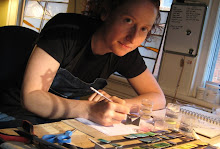
For some reason, I didn't take a many pictures of this particular step. I promise to remedy that in the next batch of jewelry. I use Japanese leaded enamels, but I met the Bovano guys at my last show, and I keep meaning to get some samples from them. Part of the pure pleasure of enameling is seeking out new colors and making samples. Here's a picture of my color samples:

As most of you know, the enamels are in powder form. Before use, they need to be washed, so that all the little bits of dust and micro-particles will be removed and the enamels will be pure, delicious, and vibrant. (and not cloudy!). I put a little enamel powder in a cup and top off with distilled water. After letting things settle, I pour off all the water into a large bucket. I'll repeat this process at least 7 or 8 times, maybe more, maybe less. Depends. When things settle and the water is perfectly crystal clear, you're done.
 Since these are leaded enamels, I always wear a respirator until all the enamels are under water. (And, for the record, I use unleaded enamels on the reverse sides of my jewelry, because I just don't like to sift leaded if I don't have to.) Safety first, you guys!
Since these are leaded enamels, I always wear a respirator until all the enamels are under water. (And, for the record, I use unleaded enamels on the reverse sides of my jewelry, because I just don't like to sift leaded if I don't have to.) Safety first, you guys!










